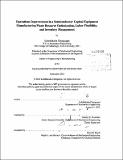| dc.contributor.advisor | Stanley B. Gershwin. | en_US |
| dc.contributor.author | Chengappa, Lohithaksha | en_US |
| dc.contributor.other | Massachusetts Institute of Technology. Dept. of Mechanical Engineering. | en_US |
| dc.date.accessioned | 2013-03-28T18:10:03Z | |
| dc.date.available | 2013-03-28T18:10:03Z | |
| dc.date.copyright | 2012 | en_US |
| dc.date.issued | 2012 | en_US |
| dc.identifier.uri | http://hdl.handle.net/1721.1/78166 | |
| dc.description | Thesis (M. Eng. in Manufacturing)--Massachusetts Institute of Technology, Dept. of Mechanical Engineering, 2012. | en_US |
| dc.description | Cataloged from PDF version of thesis. | en_US |
| dc.description | Includes bibliographical references (p. 143-145). | en_US |
| dc.description.abstract | A semiconductor capital equipment manufacturing plant is a high-mix low-volume manufacturing environment where the complex products produced requires skilled manual assembly and expensive raw materials. The semiconductor capital equipment industry is sporadic with high demand variability and hence, semiconductor capital equipment manufacturers must be able to allocate resources to meet demand at minimum cost to maintain their manufacturing competitiveness. This thesis draws heavily on the research done at Varian Semiconductor Equipment, a manufacturer of ion implantation machines for the semiconductor industry, over a period of seven months as part of the Master of Engineering in Manufacturing program at the Massachusetts Institute of Technology and aims to enable Varian to make optimal resource allocation, capacity planning and personnel decisions that will allow it to meet demand at minimum cost. The goal of this thesis is achieved through the development of three optimization models, a labor flexibility framework, and an inventory management policy. The first optimization model, resource optimization for cost minimization, will allow Varian to determine the optimal combination of workers and assembly bays for each production process that will allow it to meet demand at minimum cost. The second optimization model, labor cost minimization, will enable Varian to determine the optimal combination of regular time and overtime that will allow it to meet demand at minimum labor cost. The final model, labor flexibility, will allow Varian to determine the optimal movement of workers that will allow the Varian's plant to meet demand with the minimum total cost of work hours to be provided. The final model is based on a labor flexibility framework introduced in this thesis. We also present an inventory management policy to manage certain assemblies produced at Varian's supermarket build area that will allow Varian to reduce those assemblies' safety stock levels by 30%. | en_US |
| dc.description.statementofresponsibility | by Lohithaksha Chengappa. | en_US |
| dc.format.extent | 148 p. | en_US |
| dc.language.iso | eng | en_US |
| dc.publisher | Massachusetts Institute of Technology | en_US |
| dc.rights | M.I.T. theses are protected by
copyright. They may be viewed from this source for any purpose, but
reproduction or distribution in any format is prohibited without written
permission. See provided URL for inquiries about permission. | en_US |
| dc.rights.uri | http://dspace.mit.edu/handle/1721.1/7582 | en_US |
| dc.subject | Mechanical Engineering. | en_US |
| dc.title | Operations improvement in a semiconductor capital equipment manufacturing plant : resource optimization, labor flexibility, and inventory management | en_US |
| dc.type | Thesis | en_US |
| dc.description.degree | M.Eng.in Manufacturing | en_US |
| dc.contributor.department | Massachusetts Institute of Technology. Department of Mechanical Engineering | |
| dc.identifier.oclc | 829683741 | en_US |
